Castle Clinton
Castle Clinton or Fort Clinton, previously known as Castle Garden, is a circular sandstone fort now located in Battery Park, in Manhattan, New York City. Built from 1808 to 1811, it was the first U.S. immigration station (predating Ellis Island), where more than 8 million people arrived in the United States from 1855 to 1890. Over its active life, it has also functioned as a beer garden, exhibition hall, theater, and public aquarium. Castle Clinton National Monument was listed on the National Register of Historic Places on October 15, 1966.
Castle Clinton National Monument Castle Garden | |
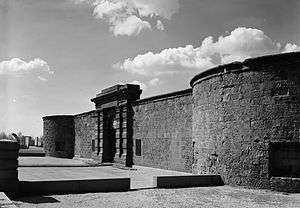 Castle Clinton in Battery Park Photo: Historic American Buildings Survey | |
 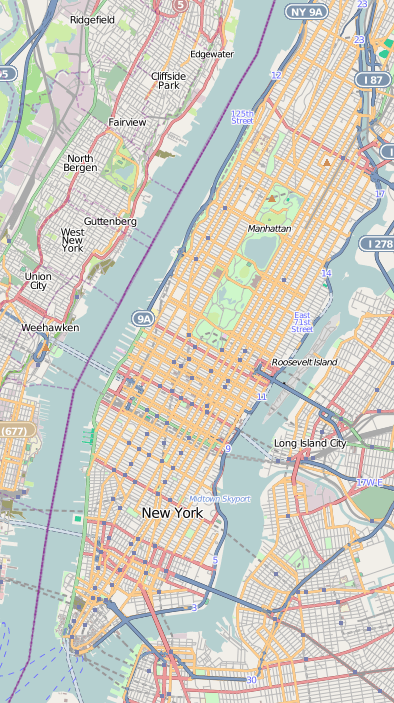   | |
| Location | Battery Park, Manhattan, New York City |
|---|---|
| Coordinates | |
| Area | 1 acre (0.40 ha) |
| Built | 1808 |
| Architect | John McComb Jr.; Jonathan Williams; U.S. War Department |
| Visitation | 2,949,231 (2004) |
| Website | Castle Clinton National Monument |
| NRHP reference No. | 66000537 |
| Significant dates | |
| Added to NRHP | October 15, 1966[1] |
| Designated NMON | August 12, 1946 |
| Designated NYCL | November 23, 1965 |
Original use
Castle Clinton stands slightly west of where Fort Amsterdam was built in 1626, when New York City was known by the Dutch name New Amsterdam.[2] Fort Amsterdam was demolished by 1790 after the American Revolutionary War.[3][4][5] Proposals for a new fort were made after two separate war scares involving Britain and France in the 1790s, but neither plan was ultimately carried out.[6] By 1805, there were growing tensions between Britain and the U.S., which would mark the run-up to the War of 1812. Late that year, Lieutenant Colonel Jonathan Williams of the United States Army Engineers began planning a series of fortifications in New York Harbor.[7] Williams was part of a group of three commissioners who, in 1807, submitted a report that recommended the construction of fortifications in New York Harbor.[7][8]
Castle Clinton, originally known as West Battery and sometimes as Southwest Battery,[9][10] was built on a small artificial island just off shore.[10] Construction began in 1808 and the fort was completed in 1811,[3][9][11][12]:91 though modifications continued through the 1820s.[13] Designed by John McComb Jr. and Jonathan Williams,[14][15] West Battery was roughly circular shaped with a radius of approximately 92 feet (28 m), contained a red brick facade, and had 28 "thirty-two pounder" cannons. About one-eighth of the circle was left "unfinished", with a straight wall constructed between the "unfinished" segments.[10][13] West Battery was intended to complement the three-tiered Castle Williams, the East Battery, on Governors Island.[16] Though garrisoned in 1812,[17] the fort never saw action in any war.[16]
By 1815, West Battery was renamed Castle Clinton, its current official name, in honor of New York City Mayor DeWitt Clinton (who eventually became Governor of New York).[10][3][16] The castle itself was converted to administrative headquarters for the Army. Simultaneously, at the end of the war, there was a public movement to build a park in the Battery area.[16] A 1816 proposal to construct two small office buildings at Castle Clinton was canceled due to public opposition, and the castle lay dormant for three years.[18][16] Even in 1820, it was only being used as a paymaster's quarters and storage area.[19] The United States Army stopped using the fort in 1821, and it was ceded to the city by an act of Congress in March 1822.[19][20][21] By then, the bridge leading to Castle Clinton was frequently used by fishermen who were catching fish from the bridge.[10]
19th century
Exhibition hall
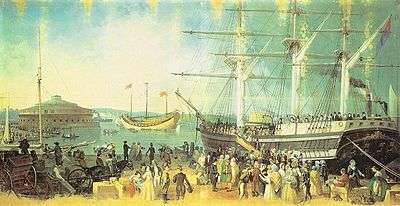
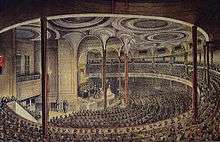
The fort was leased to New York City as a place of public entertainment in June 1824.[20] It opened as Castle Garden on July 3, 1824, a name by which it was popularly known for most of its existence.[20] It served in turn as a promenade, beer garden/restaurant, exhibition hall, opera house, and theater. Designed as an open-air structure, it was eventually roofed over to accommodate these uses.
In 1850, the castle was the site of two concerts given for charity by Swedish soprano Jenny Lind to initiate her American tour.[22] A year later, European dancing star Lola Montez performed her notorious "tarantula dance" in Castle Garden.[23] In 1853–54, Louis-Antoine Jullien, the eccentric French conductor and composer of light music, gave dozens of very successful concerts mixing classical and light music.[23] The Max Maretzek Italian Opera Company notably staged the New York premieres of Gaetano Donizetti's Marino Faliero on June 17, 1851, and Giuseppe Verdi's Luisa Miller on July 20, 1854, at Castle Garden.[24][25][26] Landfill was used to expand Battery Park during the 1860s, at which point the island containing the fort was incorporated into the rest of Manhattan Island.[10]
Immigration holding center
In the first half of the 19th century, most immigrants arriving in New York City landed at docks on the east side of the tip of Manhattan, around South Street. On August 1, 1855, Castle Clinton became the Emigrant Landing Depot, functioning as the New York State immigrant processing center (the nation's first such entity). It was operated by the state until April 18, 1890,[27] when the U. S. government assumed control of immigration processing, soon moving the center to the larger, more isolated Ellis Island facility on January 2, 1892.
After many unnecessary deaths, and scandals over immigration workers cheating and stealing from immigrants, the immigration center was moved to Ellis Island.[28] Most of Castle Clinton's original immigrant passenger records were destroyed in a fire that consumed the first structures on Ellis Island on June 15, 1897,[29] but it is generally accepted that over 8 million immigrants (and perhaps as many as 12 million) were processed during its operation. Many of these records are still extant. Called Kesselgarten by Yiddish-speaking Eastern European Jews, a Kesselgarten became a generic term for any situation that was noisy, confusing or chaotic, or where a "babel" of languages was spoken (a reference to the multitude of languages heard spoken by the immigrants from many countries at the site). Prominent persons associated with the administration of the immigrant station included Gulian Crommelin Verplanck, Friedrich Kapp, and John Alexander Kennedy.
20th century to present
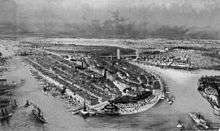
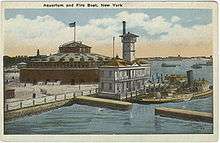
From 1896 to 1941, Castle Garden was the site of the New York City Aquarium. For many years, it was the city's most popular attraction, drawing hundreds of thousands of visitors each year. The structure was extensively altered and roofed over to a height of several stories, though the original masonry fort remained.[30][31]
In 1941, Triborough Bridge and Tunnel Authority Commissioner Robert Moses wanted to tear the structure down completely, claiming that this was necessary to build the Brooklyn–Battery Tunnel.[32] To expedite construction of the tunnel, the city closed the New York Aquarium and moved its fish to other aquariums in September 1941.[33] Moses advocated for the demolition of Castle Clinton,[34] but preservationists who opposed Moses's proposed action asked a federal judge to grant an injunction to prevent demolition.[35] Even though Moses initially got the injunction dismissed,[36] the public outcry prevented his effort at demolition. However, the aquarium was closed and not replaced until Moses opened a new facility on Coney Island in 1957.[37] Moses subsequently proposed creating a Fort Clinton memorial on the site, but would only keep Castle Clinton if the federal government agreed to pay for its restoration.[38] Albert S. Bard, Walter D. Binger, and other civic reformers advocated to save the castle, which resulted in both houses of the United States Congress passing legislation to make the castle a U.S. historic monument.[39] President Harry S. Truman signed the legislation on August 12, 1946.[40]
Although Castle Garden had been designated a national monument, the city still owned the property. In July 1947, the New York City Board of Estimate voted to demolish Castle Garden.[41] However, the Board delayed the demolition for another year to allow the federal government to review the decision.[42] In May 1948, the Board voted to demolish the castle for the sixth time in as many years.[43] After another year of discussion, the New York State Assembly reversed its decision to allow the castle to be demolished.[44] The federal government finally obtained the property on July 18, 1950, after the city deeded the land and castle to the federal government.[45] A project to renovate Castle Clinton was announced in 1956 after funding had been secured.[46]
A major rehabilitation took place in the 1970s, and Castle Clinton reopened in 1975.[47] It is currently administered by the National Park Service and is a departure point for visitors to the Statue of Liberty and Ellis Island. In addition, the fort contains a small history exhibit and occasionally hosts concerts. Castle Clinton has largely been restored to its original appearance.[48]
References
Notes
- "National Register Information System". National Register of Historic Places. National Park Service. March 13, 2009.
- National Park Service 1960, p. 5 (PDF p. 10).
- "The Battery Highlights : NYC Parks". New York City Department of Parks & Recreation. June 26, 1939. Retrieved May 7, 2019.
- Jackson 2010, p. 472.
- Gilder 1936, p. 113.
- National Park Service 1960, p. 8 (PDF p. 13).
- Gilder 1936, p. 129.
- National Park Service 1960, p. 9 (PDF p. 14).
- Jackson 2010, p. 102.
- Gilder 1936, p. 130.
- Dunlap, David (May 27, 2015). "A Transformation at the Battery, 21 Years in the Making". The New York Times. ISSN 0362-4331. Retrieved August 14, 2015.
- Steinberg, Ted (2015). Gotham Unbound: The Ecological History of Greater New York. Simon & Schuster. pp. 90–91. ISBN 978-1-4767-4128-4. Retrieved May 7, 2019.
- National Park Service 1960, p. 15 (PDF p. 28).
- National Park Service 1960, p. 14 (PDF p. 21).
- White, Norval; Willensky, Elliot & Leadon, Fran (2010). AIA Guide to New York City (5th ed.). New York: Oxford University Press. p. 6. ISBN 978-0-19538-386-7.
- National Park Service 1960, p. 12 (PDF p. 19).
- National Park Service 1960, p. 10 (PDF p. 17).
- Gilder 1936, p. 143.
- National Park Service 1960, p. 13 (PDF p. 20).
- Gilder 1936, p. 146.
- United States. Congress (1860). American State Papers: Documents, Legislative and Executive, of the Congress of the United States. American State Papers: Documents, Legislative and Executive, of the Congress of the United States. Gales and Seaton. p. 6. Retrieved May 7, 2019.
- Gilder 1936, p. 188.
- Gilder 1936, p. 194.
- Brodsky Lawrence 1995, p. 314.
- Martin 2011, p. 184.
- Gilder 1936, p. 195.
- About.com, "Castle Garden – America's First Official Immigration Center"
- LeMay, Michael (2013). Transforming America: Perspectives on U.S. Immigration. Santa Barbara, California: ABC-CLIO, LLC. pp. 204–206. ISBN 978-0-313-39643-4.
- "FIRE ON ELLIS ISLAND; It Broke Out Shortly After Midnight in the Furnace of the Main Building. THE FIREBOAT NEW YORKER AND POLICE BOAT PATROL HAVE GONE TO THE SCENE. Communication With Island Was Cut Off -- It Was Reported that All Persons Escaped With Their Lives". The New York Times. June 15, 1897. ISSN 0362-4331. Retrieved March 22, 2018.
- "The Battery Highlights : NYC Parks". New York City Department of Parks & Recreation. June 26, 1939. Retrieved May 7, 2019.
- History of The Battery, The Battery Conservancy. Retrieved December 1, 2014.
- "BATTERY AQUARIUM TO BE DEMOLISHED; Doomed by Brooklyn Tunnel, It Will Be Replaced by a Modern One in Bronx COST PUT AT $2,000,000 Modern Exhibition Technique to Be Utilized to Mirror Nature, Osborn Says". The New York Times. February 8, 1941. ISSN 0362-4331. Retrieved March 21, 2018.
- "FISH TO LEAVE OLD HOME; Aquarium to Start Dispersing Thousands of Specimens". The New York Times. September 23, 1941. ISSN 0362-4331. Retrieved March 21, 2018.
- "AQUARIUM DOOMED BY ESTIMATE BOARD; Moses Scoffs at Proposal to Restore Old Fort, Saying It 'Never Fired a Shot' MANY PLEAD FOR SAVING IT But the Vote Is 11 to 5 for Demolition to Make Way for Battery Tunnel". The New York Times. June 26, 1942. ISSN 0362-4331. Retrieved March 22, 2018.
- "INJUNCTION SOUGHT TO SAVE AQUARIUM; Suit Today Will Ask Court to Restrain Moses From Razing Fort Clinton". The New York Times. August 20, 1942. ISSN 0362-4331. Retrieved March 22, 2018.
- "MOSES WINS FIGHT TO RAZE AQUARIUM; Court of Appeals Has Denied Injunction Sought by Civic Groups Opposing Him ACTION WAS BEGUN IN 1941 Contest Was Marked by Fierce Exchange Between Park Chief and Pierce T. Wetter". The New York Times. April 25, 1943. ISSN 0362-4331. Retrieved March 22, 2018.
- Caro, Robert (1974). The Power Broker: Robert Moses and the Fall of New York. New York: Knopf. ISBN 978-0-394-48076-3. OCLC 834874.
- "A Proposed Improvement for the City's Battery Park". The New York Times. April 10, 1947. ISSN 0362-4331. Retrieved May 13, 2019.
- "SENATE APPROVES THE AQUARIUM BILL; Measure to Set Up the Castle Clinton National Monument Is Sent to Truman M'ANENY DEFENDS MOVE Disputes Park Association's Opposition to the Acquisition, Denies Tunnel Interference McAneny Defends Project Plymouth Rock". The New York Times. July 31, 1946. ISSN 0362-4331. Retrieved March 22, 2018.
- "AQUARIUM BLOCK MADE A MONUMENT; Truman Signs Bill Designating Castle Clinton, Battery Park, a National Shrine". The New York Times. August 13, 1946. ISSN 0362-4331. Retrieved March 22, 2018.
- Crowelx, Paul (July 25, 1947). "CITY VOTES DEATH OF OLD AQUARIUM; 5-Year Controversy Is Ended as Board of Estimate Allots $50,000 for Demolition MOSES SCORES A VICTORY Final Blow to Memorial Plan Results From Lack of U.S. Funds for Restoration CITY VOTES DEATH OF OLD AQUARIUM". The New York Times. ISSN 0362-4331. Retrieved March 22, 2018.
- "City to Give Government Chance To Prevent Aquarium Demolition; Board of Estimate Agrees to Delay Razing of Castle Clinton to Permit Congress to Vote Funds for Restoration". The New York Times. August 28, 1947. ISSN 0362-4331. Retrieved March 22, 2018.
- "Estimate Board Votes to Complete Demolition of Old Aquarium Here; DEMOLITION VOTED FOR OLD AQUARIUM". The New York Times. May 28, 1948. ISSN 0362-4331. Retrieved March 22, 2018.
- "RESTORATION VOTED FOR CASTLE CLINTON; Assembly Committee Clears Bill Making Possible a U. S. Monument at the Battery GROUP REVERSES' 48 STAND Floor Action Is Expected Next Week on Measure Allowing City to Relinquish Title". The New York Times. March 16, 1949. ISSN 0362-4331. Retrieved March 22, 2018.
- "AQUARIUM BECOMES A U.S. MONUMENT; Action on Castle Clinton at Battery Taken After City Deeds Site to Government MUCH WORK TO BE DONE Building Started in 1808 Now Only a Shell--$166,750 in Restoration Funds Work Started in 1808 Announcement Is Hailed". The New York Times. July 19, 1950. ISSN 0362-4331. Retrieved March 22, 2018.
- Bennett, Charles G., Jr. (July 3, 1956). "OLD BATTERY FORT WILL BE RESTORED; Through the Centuries With Castle Clinton, Whose Future Is Bright once More". The New York Times. ISSN 0362-4331. Retrieved May 15, 2019.
- "Castle Clinton Reopens As National Monument". The New York Times. June 21, 1975. ISSN 0362-4331. Retrieved May 15, 2019.
- "Basic Information". Castle Clinton National Monument (U.S. National Park Service). March 7, 2016. Retrieved June 17, 2019.
Citations
- Brodsky Lawrence, Vera (1995). Strong on Music: The New York Music Scene in the Days of George Templeton. University of Chicago Press.CS1 maint: ref=harv (link)
- Gilder, Rodman (1936). The Battery: the story of the adventurers, artists, statesmen, grafters, songsters, mariners, pirates, guzzlers, Indians, thieves, stuffed-shirts, turn-coats, millionaires, inventors, poets, heroes, soldiers, harlots, bootlicks, nobles, nonentities, burghers, martyrs, and murderers who played their parts during full four centuries on Manhattan Island's tip. Houghton Mifflin.CS1 maint: ref=harv (link)
- Jackson, Kenneth T., ed. (2010). The Encyclopedia of New York City (2nd ed.). New Haven: Yale University Press. ISBN 978-0-300-11465-2.
- Martin, George Whitney (2011). Verdi in America: Oberto Through Rigoletto. Eastman studies in music. University of Rochester Press. ISBN 978-1-58046-388-1.CS1 maint: ref=harv (link)
- Moreno, Barry (2007). Castle Garden and Battery Park. Images of America. Arcadia Publishing Incorporated. ISBN 978-1-4396-1855-4.
- "Historic Structures Report, Part I, Castle Clinton" (PDF). National Park Service. May 10, 1960.
- New York Aquarium; Townsend, Charles H. (1919). Guide to the New York Aquarium. New York Zoological Society.
- Svejda, George J. (1968). Castle Garden as an Immigrant Depot, 1855–1890 (PDF).
External links

- Official website
- Castle Clinton from GORP
- The Battery Conservancy
- CastleGarden.org, searchable database of 13.3 million immigrants arriving in New York before 1892 (90% complete)

